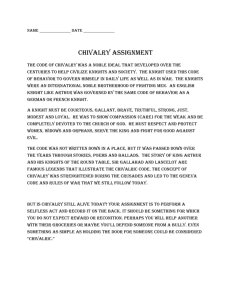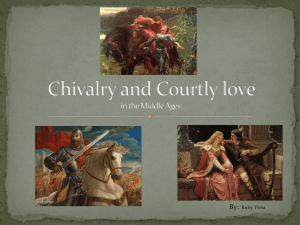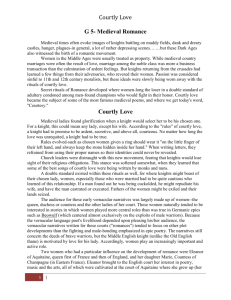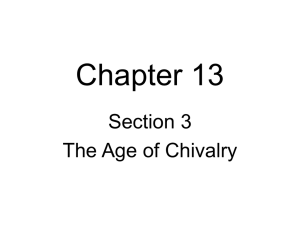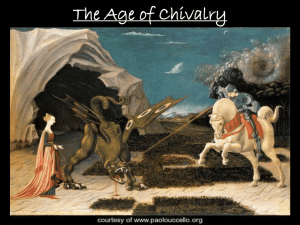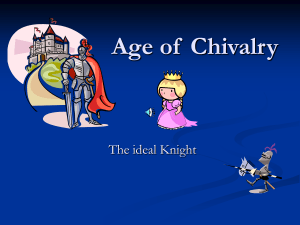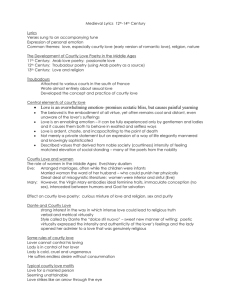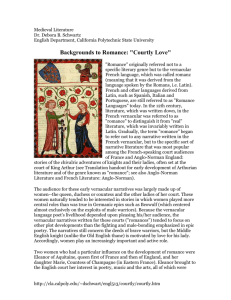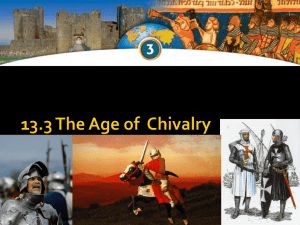Courtly Love PPT
advertisement
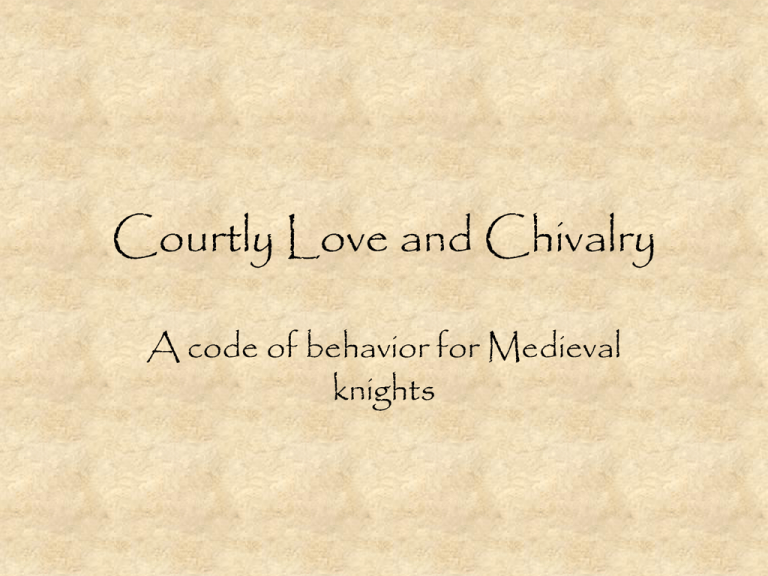
Courtly Love and Chivalry A code of behavior for Medieval knights The Medieval Knight • Medieval knights were generally younger sons of noble families. • Young noble boys would learn the arts of combat and etiquette in noble households, serving as squires befoe becoming fullfledged knights. • As a member of the “first estate,” a knight’s role in the world was to protect his country by fighting in wars. • Honor in battle was his aim, and he was expected as well to be humble, courteous, faithful to his lord and his wife, and unmotivated by material gain. • The Knight in the Canterbury Tales is an ideal in this way. Eustache Deschamps: “Du Bachelier d’Armes” You who desire the order of chivalry Must lead a new life, Lie awake in prayer devotedly, Flee sin, pride, and villeiny, Must defend the Church, The widow also, support the orphan, Be brave and guard the people, A valiant, loyal man who takes nothing from others. Thus a knight must govern himself. You must have a humble heart, always must labor in And pursue the deeds of chivalry, Fignt in just wars, be a great crusader, Engage in tournaments, and joust for your lady, Must always act honorably So that no man can find fault with you Nor find cowardice in your deeds, And among all people you must hold yourself to be least. Thus must a knight govern himself. You must cherish your lord’s rights, And above all guard his lordship, Show generosity, be a true judge, Follow the company of valiant men, Listen to and learn from their sayings, And comprehend the brave deeds of heroes, So that you can acieve great exploits, As Alexander the Great did in former times. Thus must a knight govern himself. • Since knights were only supposed to think about and practice warfare all the time, they ran into trouble during peacetime. • Knights with nothing to do were liable to start wandering the countryside raping and pillaging. This is not just because they were bored -- much of their livelihood was composed of money and goods taken from the enemy during and after battle. • To keep knights from doing this, rulers would either drum up and excuse to send them off to war, engaging them to battle for an ally, for example, or invite them to demonstrate their fighting skills in staged tournaments. • Tournaments became an increasingly popular form of entertainment during the Middle Ages, drawing spectators from all over -including ladies. Courtly Love • Associated with these tournaments was the idea of courtly love: an idealized form of love that ennobled a knight and pushed him to fight his best. • The rules of courtly love required each knight to fight for a particular lady, and to gain honor in her name. • A courtly lover swore unwavering devotion to one lady, who was coy at first and made him prove himself before she would bestow her favors. • Desire to impress his lady drove a knight to valiant acts and compelled him to act politely. • In this relationship, the lady had the upper hand, and the knight’s duty was total humble servitude and submission. • An ideal lover was lovesick all the time, struck to the heart by Cupid’s arrow and wasting away from the pains of love. • This was love for love’s sake, not for mercenary reasons -- which were the main factors determining marriage at the time. • Consequently, ideal courtly love was adulterous love. Only with an unattainable woman could a man love for love’s sake. • The ideals of chivalry and courtly love were similar; both required men to act polite and fight nobly. • Both courtly love and chivalry hinged on a concept of absolute loyalty: chivalry to one’s lord and courtly love to one’s lady. • Both had a religious connection: the chivalrous knight fought for God and country and fulfilled his God-given role in the world; courtly love was in many ways a religion of love, with rituals and commandments. Realities of Chivalry • In real life, knights were not as perfectly faithful to their lords and modest as the rules of chivalry required. Knighthood was their profession, and they fought to maintain themselves. Regular pillaging was a major component of this, and along with pillage, slaughter of innocent townspeople or less-than-noble acts were not uncommon. • On the other hand, ideals of bravery were not as compelling as chivalry demanded, and amorphous concepts of “honor” did not always hold water when faced with real mortal danger. Realities of Courtly Love • Likewise, what was idealized as love for love’s sake often boiled down to lust. • Adultery, although romanticized in literature and art, was a major sin in Medieval society. • Nor did a knight necessarily devote himself to one lady for life: The Knight of La Tour Landry describes young knights flirting with one lady, pledging undying love, and then on being turned down, seeking out another lady to pledge undying love to. • Doubtless some ladies actually did bestow themselves on young knights, but to do so was adulterous lust, not the ennobling union of romance literature. • The ideals and rules of both chivalry and courtly love may have been invented to keep order in a system in which younger sons (who did not inherit the family estate) became members of strangers’ households. Encouraging hormonal young men to fight for a nobleman’s name and sublimate his aggressions in (unconsummated) love for the nobleman’s wife would keep them from spending these energies in more destructive ways. The End Huzzah! Bibliography • Miller, Robert, ed. Chaucer: Sources and Backgrounds. New York: Oxford UP, 1977. • Schwartz, Debora. Backgrounds to Romance: “Courtly Love.” Online. Accessed 9/23/03. • Tuchman, Barbara. A Distant Mirror: The Calamitous Fourteenth Century. New York: Alfred A. Knopf, 2002.
